Late in December, and before I expected such a prompt return, the Cyclamen coum made their re-appearance. The tiny beaks of magenta broke bare earth, buds soon reflexing to flower, sturdy and gathering in number and oblivious, it seemed, to the winter. Of all the flowers that come in these darkest weeks Cyclamen coum seem to have the most stamina, flowering for what must be the best part of three months and, in that time, providing a continuity of hope. During their season, they will see the snowdrops in and out and be companion to witch hazel and wintersweet and be happy to be in the root zone where little else will grow.
The rooty places where the ground is already taken are where they prefer to be. Here they will spend their summer dormancy underground, their tubers kept cool but on the dry side and in perfect stasis. Come the autumn rains their season is activated and, without the competition of summer growth either above or around them, they are free to flower and build up a colony. Choosing the place where they can be allowed to reign is the secret and it has taken a while for me to find the perfect spot under the old hollies. The ground is steeply sloped here and the trees, with their high dense canopy and fibrous roots, make for strong competition.
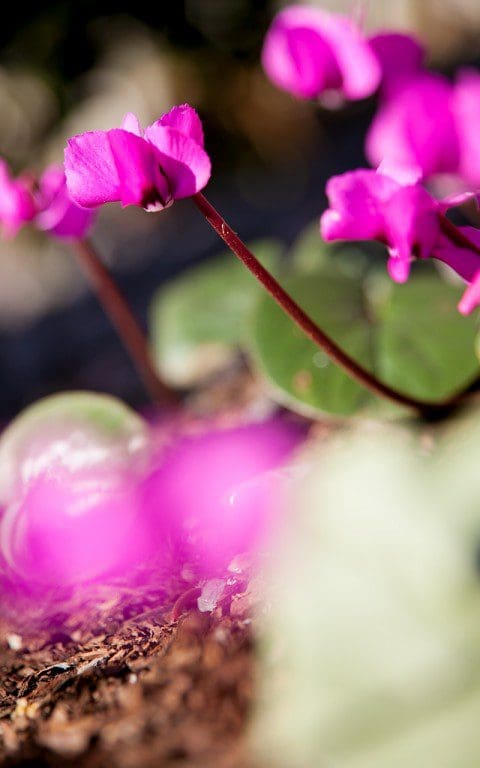 Cyclamen coum
Cyclamen coum
Cyclamen are always best planted when in growth and not bought as dormant tubers, which have often been kept too dry for too long by the suppliers. Hailing as they do from the Caucasus, Turkey, the Lebanon and Israel Cyclamen coum prefer to be kept on the dry side when dormant, which is easier and less disruptive in a pot. The second advantage to planting when they are in growth is that you can hand-pick for best leaf variation and flower colour. The leaves are as variable as pebbles on a beach. Some, often sold as the ‘Pewter Group’, are almost completely silvered, others are green overlaid with silver, and others almost entirely bottle-green. The foliage, which is the size of a chocolate coin and held close to the ground, doesn’t like competition and you have to be careful not to team them with the leafier Cyclamen hederifolium which is more vigorous and will smother them or with other winter flowering bulbs such as Eranthis, which are prone to leafiness once they start to form seed.
A dozen plants were winkled in where I could find gaps between the holly roots last winter and top-dressed with a mix of gravel and bark to do no more than cover the tubers. I hand-picked my plants for the strong magenta forms, as I prefer the punch of their pure, bright colour to the softening influence of the paler pinks and white, which is what you more often see where they have naturalised. Last year’s plants have all returned with a clutch of seedlings held tight within their crowns. These miniature new plants look true to type (or more-of-less) in terms of leaf marking, but I will see in three years or so if the flowers are true to their magenta parents.
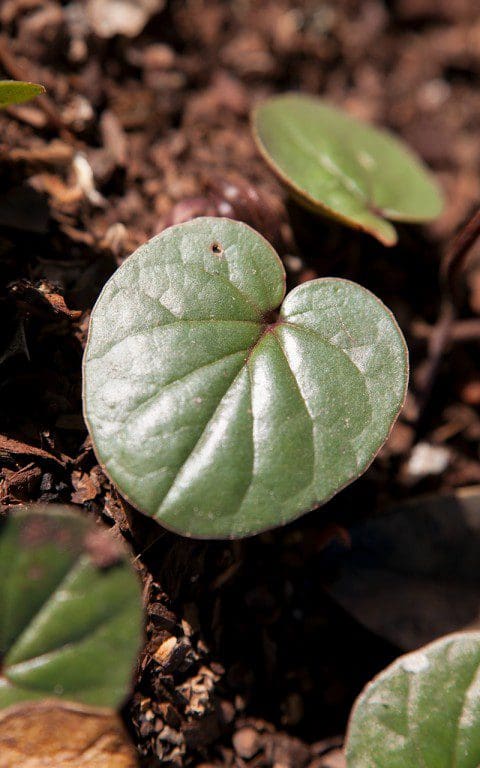
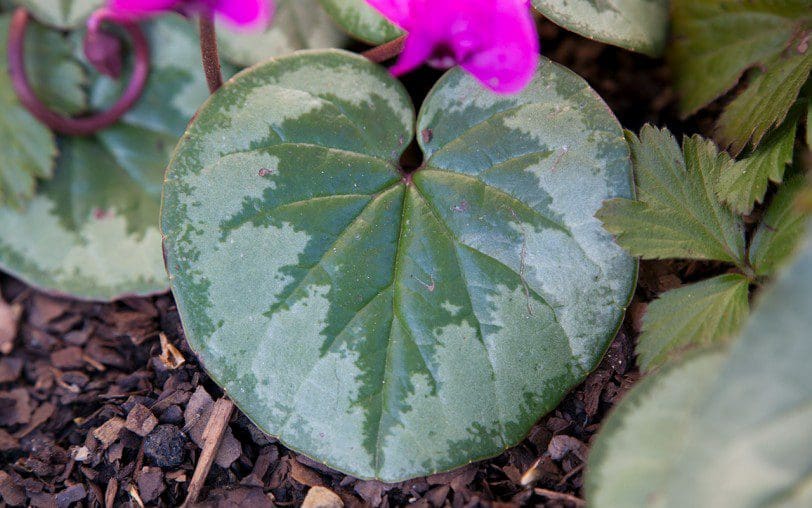
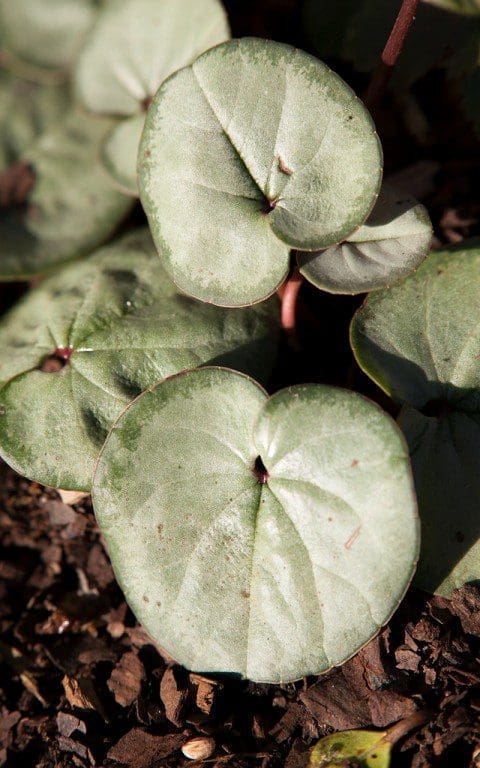 Various foliage colouration
Various foliage colouration
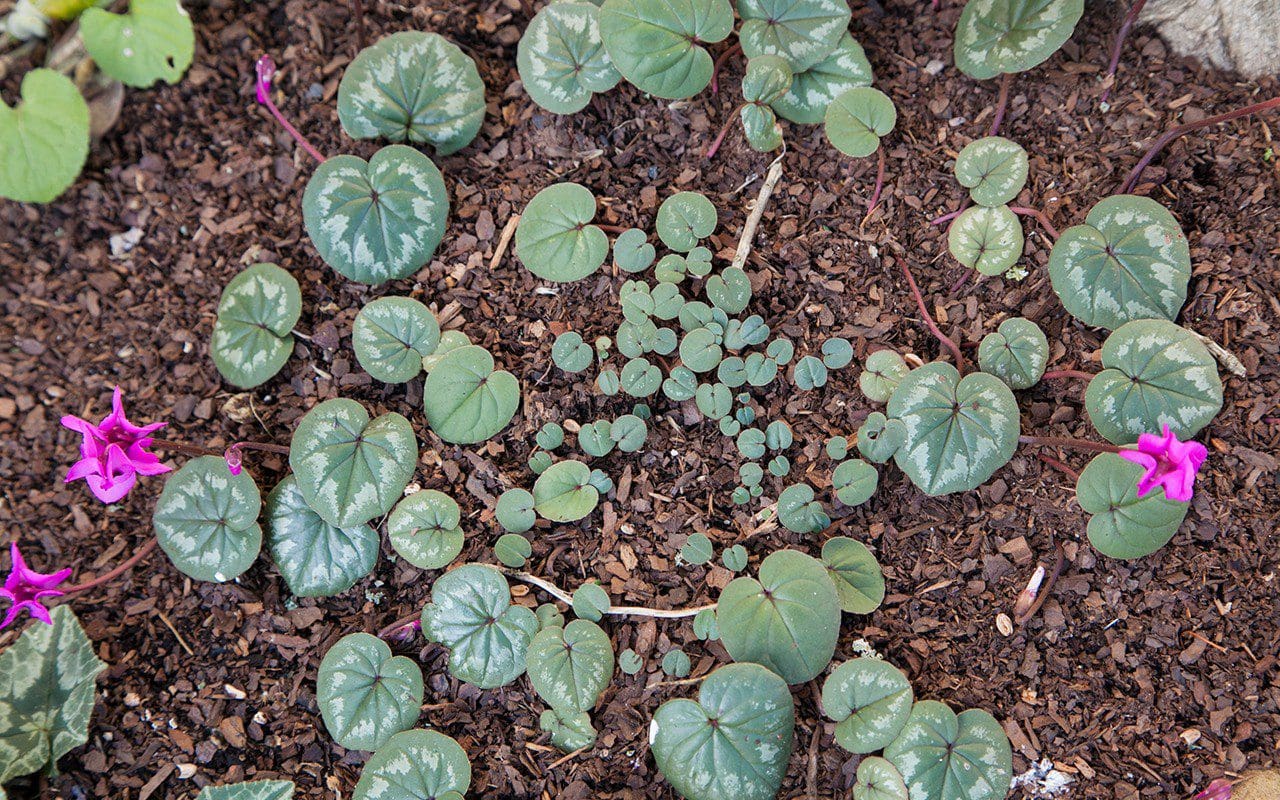 Seedlings have appeared in the crowns of last year’s plants
Seedlings have appeared in the crowns of last year’s plants
Tania Compton has raved to me about her Cyclamen coum naturalising best in pure gravel and I have hopes that mine will break free from their mound under the holly and venture into the sleeper steps that run alongside, their rubbly treads being the perfect habitat for them to run free. Cyclamen are prolific seeders if they decide they like you and a sweet coating on the seed makes them a delicacy for ants which will carry them quite some distance, so that they often appear in surprising and unexpected places. I have an image of the steps in a few years’ time being somewhere that you have to pick your way down in the winter as though on a glowing magenta runner, threadbare where our footfall influences where the cyclamen appear and where they don’t.
Words: Dan Pearson / Photographs: Huw Morgan
Published 13 January 2018
The tulips are finally over or, more to the point, we are taking control this weekend and will bring their extraordinary display to a close by lifting the bulbs and clearing the bed. As is the way with Christmas decorations, I feel almost as much pleasure in finally stripping away their ornamentation after the period of illumination and, for a moment, for there to be quiet. And, with the cool, dry weather this year, they have been flowering for a full six weeks.
We started growing tulips in earnest in the garden in Peckham, ordering a handful of varieties to fill the pots on the terraces. Each year, a favourite was kept on to get to know it better and winkled into the beds to see if it would last in the ground. That was how we discovered that we preferred ‘Sapporo’ to ‘White Triumphator’, for the fact that it ages from primrose to ivory, and it has been hard to match the perfume and vibrant tangerine of ‘Ballerina’.
When we moved here we continued to experiment, upping the number of varieties and planting the tulips in rows in the vegetable garden to slowly build an armoury of favoured varieties. As we became more confident with our experimentations and learned how to extend the season by including early, mid and late season tulips, we began a to grow them altogether differently.
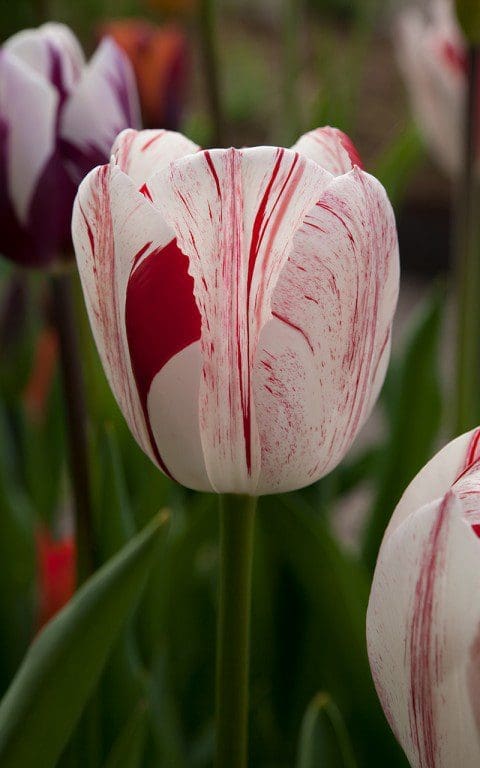 Tulipa ‘Sorbet’
Tulipa ‘Sorbet’
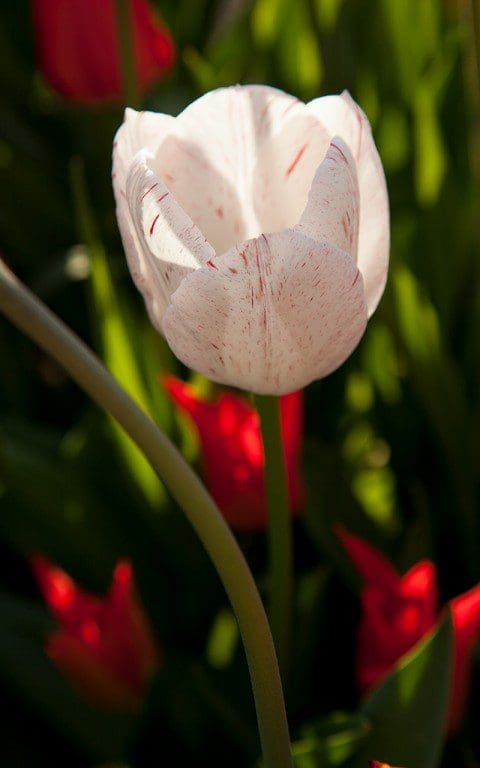 Tulipa ‘Sorbet’
Tulipa ‘Sorbet’
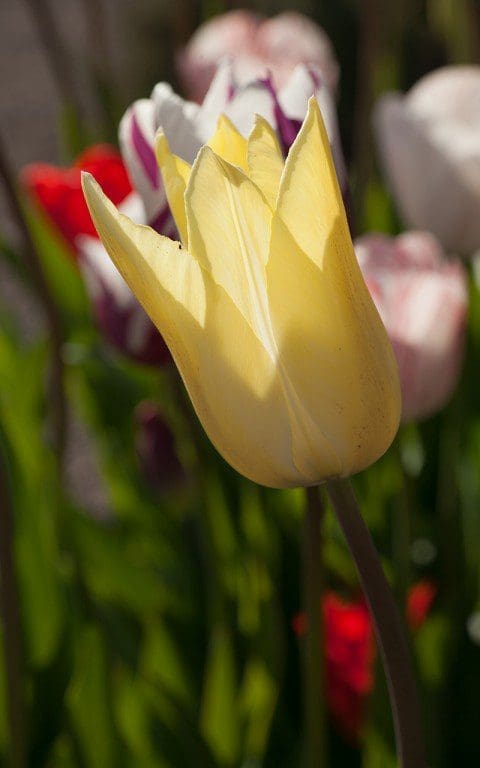 Tulipa ‘First Proud’
Tulipa ‘First Proud’
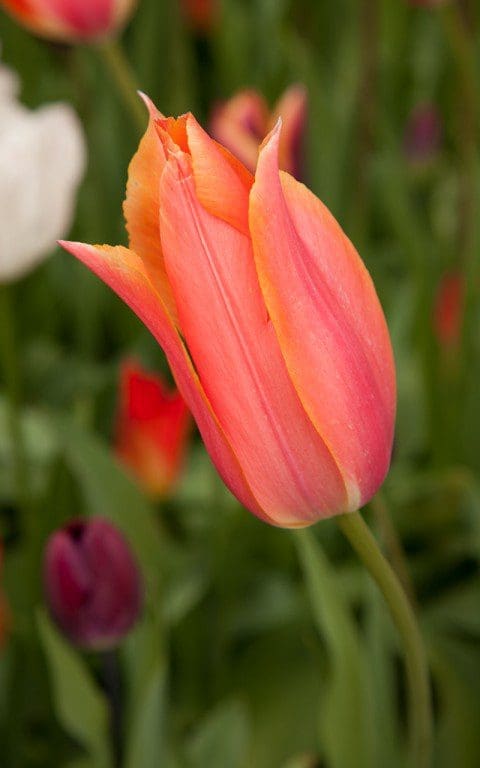 Tulipa ‘Perestroyka’
Tulipa ‘Perestroyka’
I was in the process of planting up a client’s walled garden and, for cutting as much as display, we created a series of mixes to play with the sheer breadth of varieties. We chose colour combinations to conjour a series of moods and colour fields, some dark, some pale or pastel, but always with a top or bottom note of vibrancy or depth to offset the predominating mood. The flowering groups were combined together to lengthen the season so that the early varieties were covered for by the late, and short with tall so that the combinations were layered. We also included differing types – doubles, parrots, flamed, fringed and picotee – for that sweetie box feeling of delight in variety.
At home, this has now become the favoured way of keeping up the experiment. Each year we buy thirty or fifty bulbs of up to eight varieties and dedicate a bed in the kitchen garden exclusively to a spring display. We have moved them from bed to bed to avoid Tulip Fire. Tulips are most prone to the fungal infection when repeatedly grown in the same ground, but rotate on a three or five year cycle and you will diminish the chance of infection. In combination with our thirst to try new varieties, it has also been the reason that, at the end of the season, we discard the bulbs and start again with a new batch for November planting. The bulbs, which are cheap enough to buy in quantity wholesale, are planted late at the end of the bulb planting season. They are debagged and thoroughly mixed on a tarpaulin before being spread evenly on the surface of the bed and winkled in with a trowel a finger’s width apart so that they are not touching.
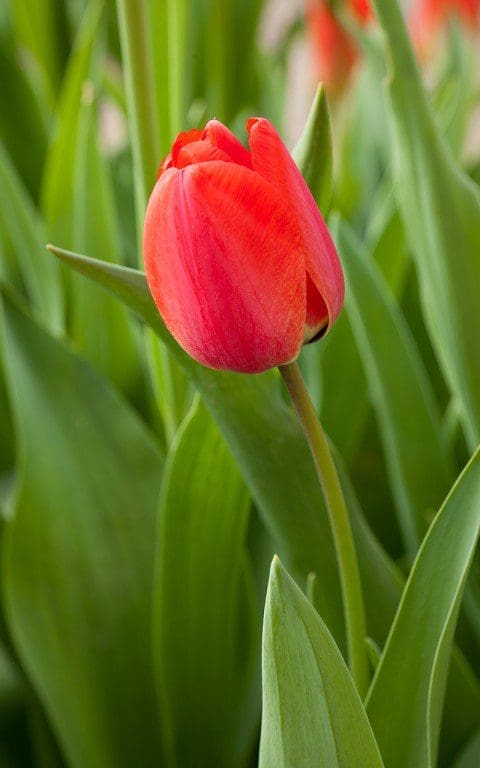
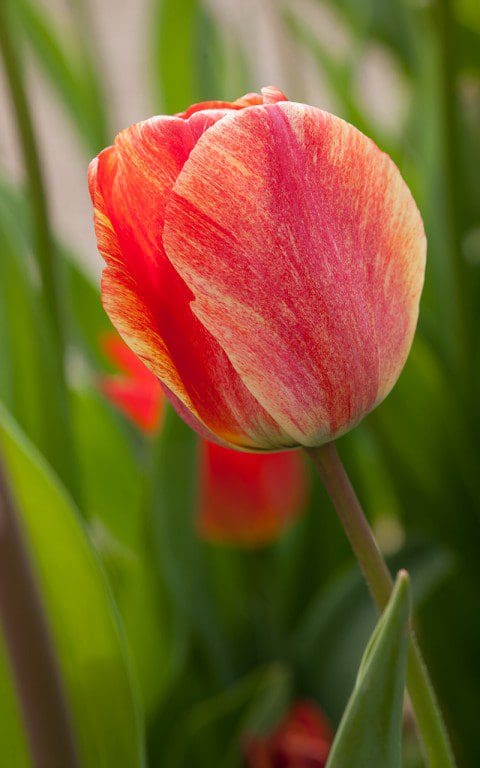
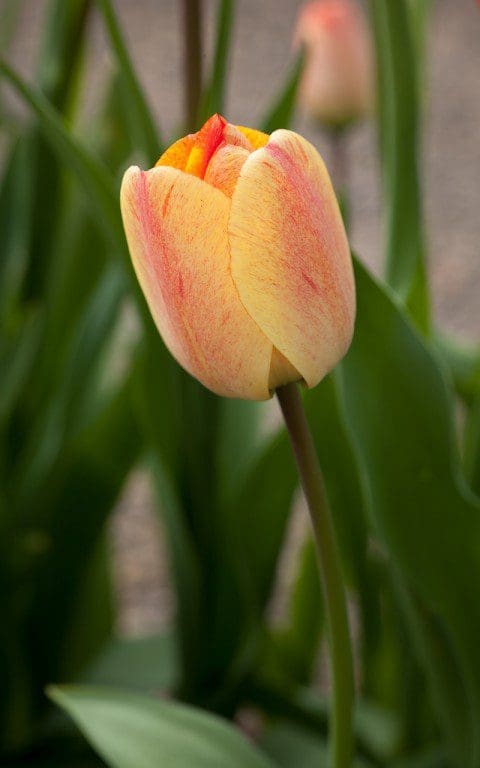 Three forms of Tulipa ‘Gudoshnik’
Three forms of Tulipa ‘Gudoshnik’
This year we have also started growing the Broken and Breeder tulips from the Hortus Bulborum Foundation. This range of old varieties – some of which date back to the 17th century – fell out of popularity in the 1920’s because, in the main, they are late flowering, and the quest for colour to break with winter began to favour the earlier flowering varieties. Their lateness has been a delight, as they have come just as we have begun to tire of the resilience of the modern tulips. Because they are choice (and expensive) we bought just three or five of each, combining them in pans and planting an individual specimen of each in 5 inch clay pots, so that they could be brought into the house for close observation.
Inside, they last for a week in a cool room and continue to evolve whilst in residence, their more subtle colouring, feathering and breaks filling out and flushing in the maturing process. They feel precious and not disposable like the Dutch tulips, so we plan to try and keep the bulbs when they are over. I will grow them on to feed the bulbs for six weeks after they have flowered, before drying and storing the bulbs in the shed until the autumn. I am hoping they will come to more than just leaf next year.
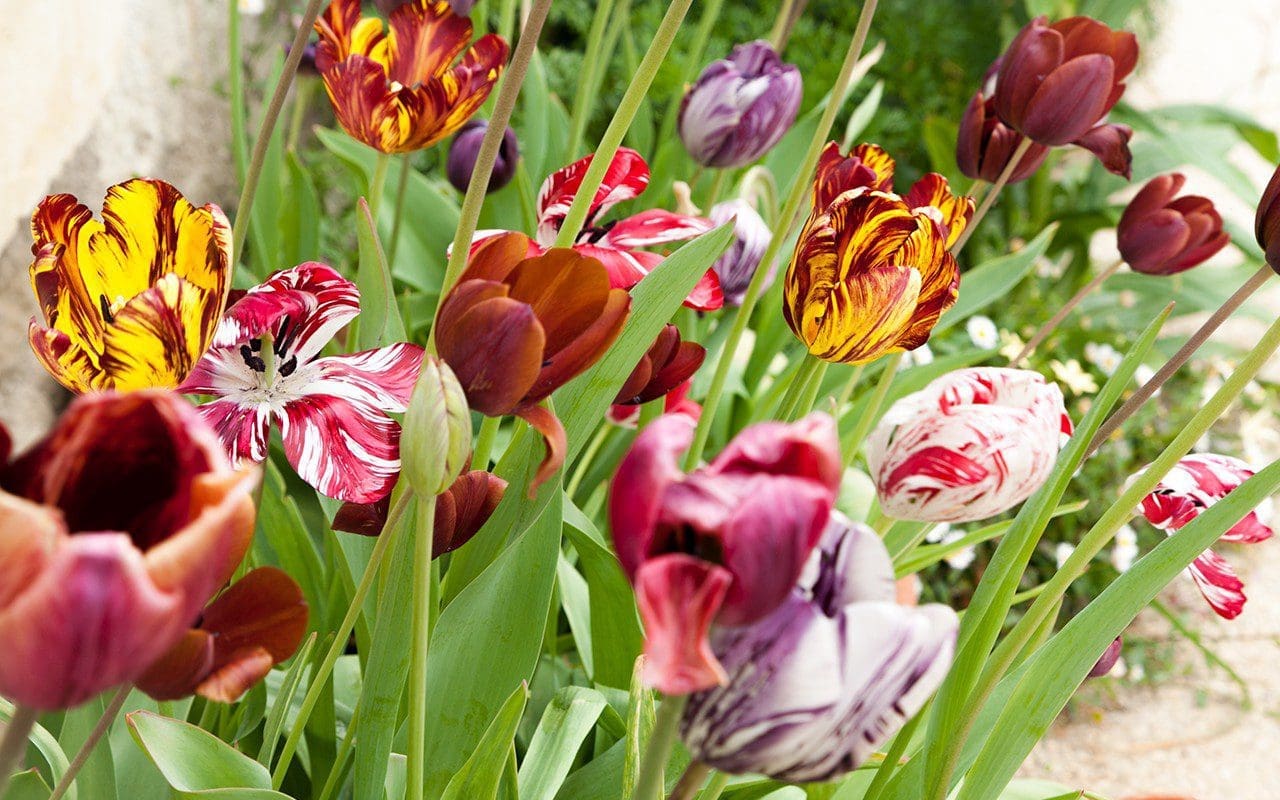 A mix of Broken and Breeder tulips from Hortus Bulborum
A mix of Broken and Breeder tulips from Hortus Bulborum
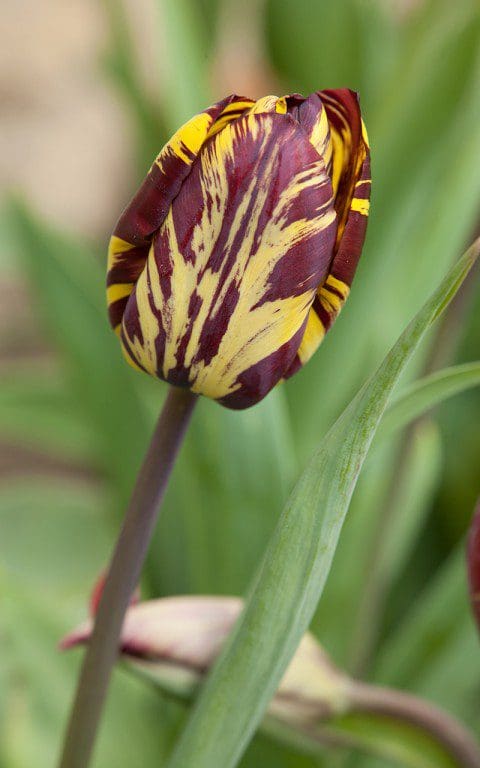 Tulipa ‘Absalon’
Tulipa ‘Absalon’
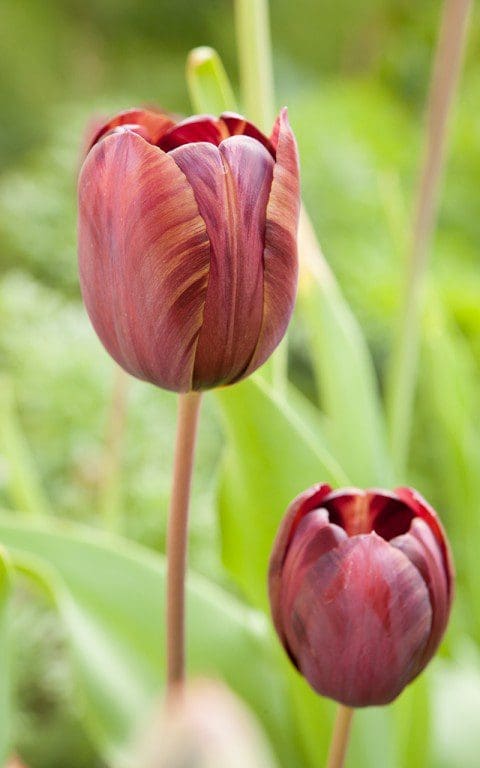 A more subtly marked form of Tulipa ‘Absalon’
A more subtly marked form of Tulipa ‘Absalon’
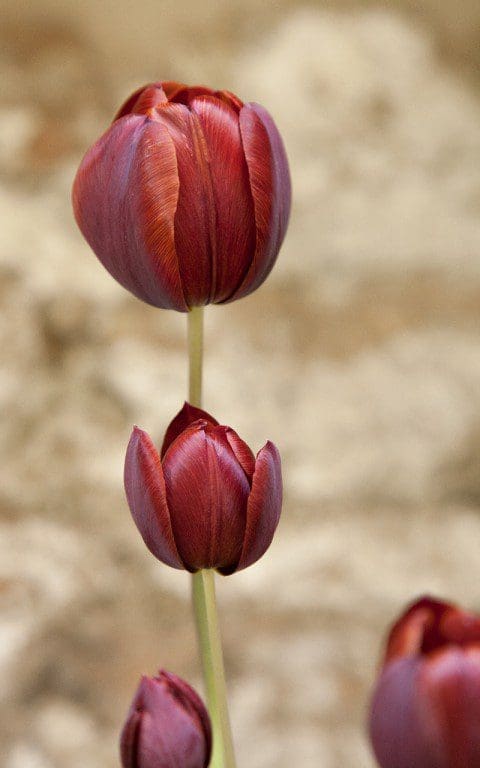 Tulipa ‘Prince of Wales’
Tulipa ‘Prince of Wales’
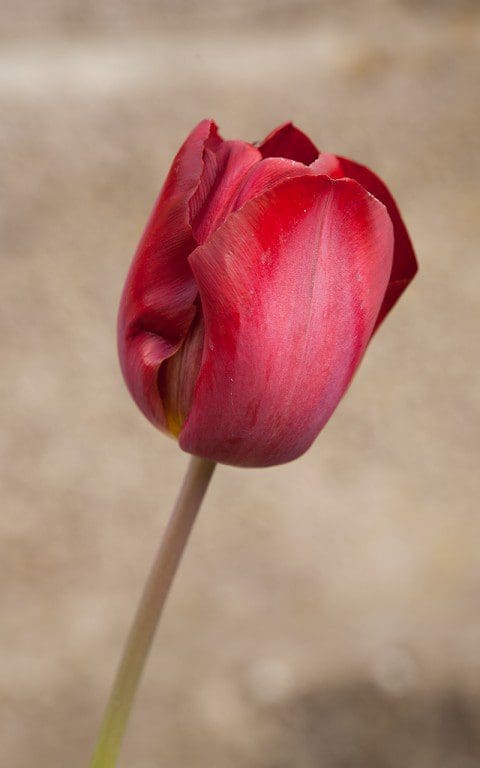 Tulipa ‘Lord Stanley’
Tulipa ‘Lord Stanley’
As cut flowers tulips continue to grow, their stems often lengthening as much as a foot or more in a tall-flowered variety such as ‘First Proud’. This has been a new favourite this year, rising up to 90cm; as tall as, but later than, ‘Perestroyka’. A mixed selection of varieties is also good in a bunch and, as they age, the stems arch and lean, sensing each other it seems, so that a vase full will fan out like a firework exploding. The flowers change too, opening and closing with the heat and light and changing colour, sometimes intensifying, sometimes bruising from tone to tone as they fade. The mercurial colour changes are the most interesting and offer far more in terms of value than those that change less, and a new personal favourite this year has been ‘Gudoshnik’, the flowers of which you would swear were different varieties; some are pure vermilion, others red with yellow feathering, others yellow with red streaks. We have also enjoyed the raspberry ripple breaks and freckling of ‘Sorbet’.
If you are experimenting as we are the mixes can be hit or miss, and this year’s wasn’t one of the best, because we didn’t warm to a couple of varieties that have thrown the colour off. We won’t be growing ‘Zurel’ again. The flowers are boxy, the petals stiff and waxy and the flaming is rather coarse. ‘Slawa’ was worth a try, because it looked interesting when we ordered from the catalogue, but it felt too graphic in the mix. The colour combination of peach and plum needs careful placing, and the flowers are less graceful than some. Harsh criticism, perhaps, but a good combination is easily let down by an element that isn’t quite right.
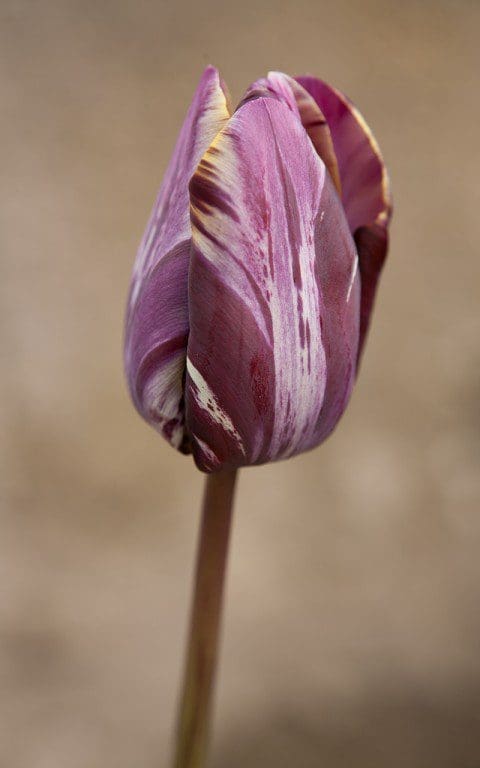 Tulipa ‘Insulinde’
Tulipa ‘Insulinde’
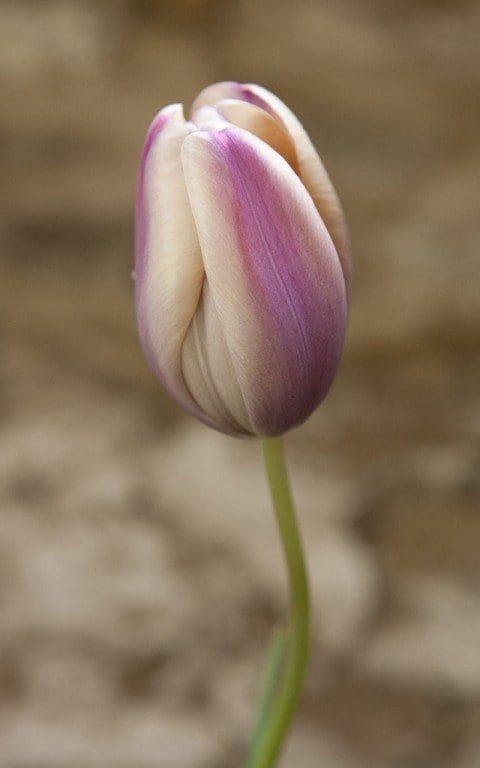 Tulipa ‘Marie-Louise’
Tulipa ‘Marie-Louise’
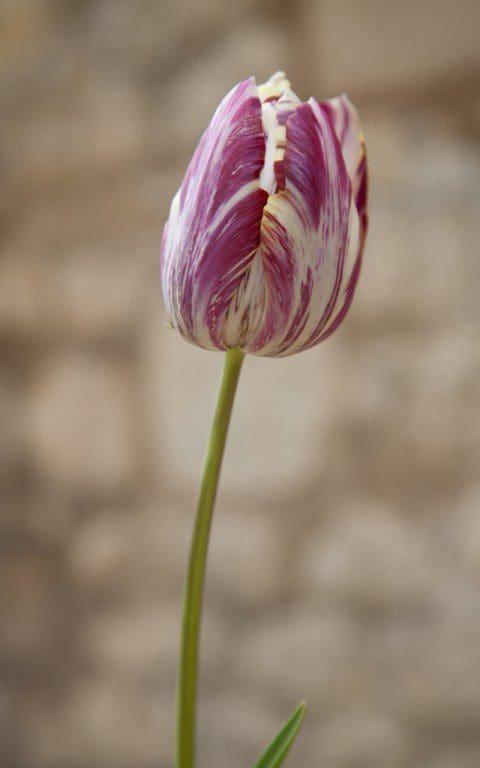 Tulipa ‘Beauty of Bath’
Tulipa ‘Beauty of Bath’
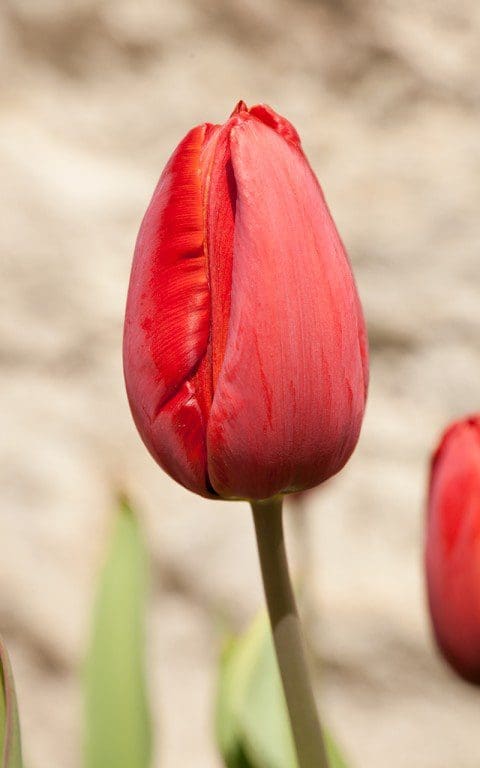 Tulipa ‘Panorama’
Tulipa ‘Panorama’
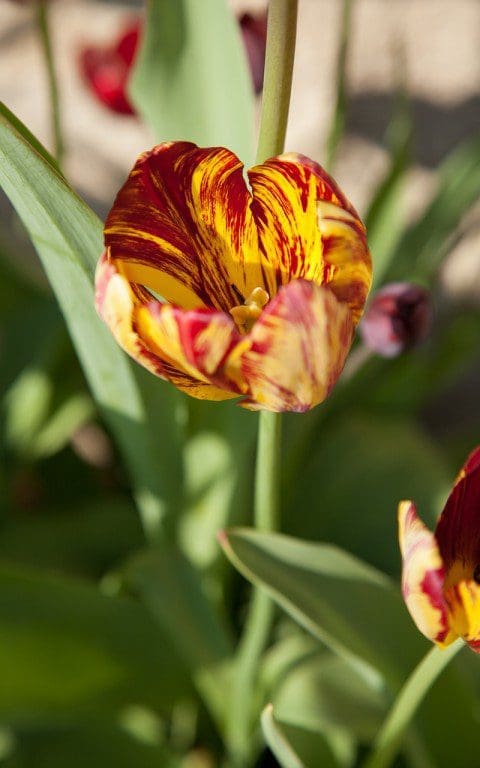 Tulipa ‘Royal Sovereign’
Tulipa ‘Royal Sovereign’
The less successful varieties were also shown in a new light by the older varieties. The breaks, feathering and flaming of the Broken tulips, and the rich tones and pastel gradations of the Breeder tulips are altogether more sophisticated. Put side by side the latter are certainly a rather superior race. Not without their problems I’m guessing, because they are less robust in appearance when compared to the modern hybrids. Particular favourites have been ‘Insulinde’, streaked the colours of blackcurrant fool, ‘Marie Louise’, a Breeder of a delicate, graduated lavender pink, ‘Panorama’, a Breeder of a strong copper orange and ‘Absalon’, a Broken tulip (and one of the original Rembrandt tulips) which has ranged from the flamed, blood-red and yellow you see in illustrations to a more subtle mix of mahogany streaked with tan, like an old-fashioned humbug.
Though we have heard much about their growing popularity, seeing them in the flesh has been a little like discovering really good chocolate. I fear we have now been spoiled and it won’t be possible to be without them.
Words: Dan Pearson / Photographs: Huw Morgan
Published 13 May 2017
Yellow breaks with winter. Soft catkins streaming in the hazel. Brightly gold and blinking celandines studding the sunny banks. They are shiny and light reflecting and open with spring sunshine. As strong as any colour we have seen for weeks and welcome for it.
There is more to come, and in rapid succession, now that spring is with us. The first primroses in the hollows and dandelions pressed tight in grass that is rapidly flushing. Daffodils in their hosts, pumping up the volume and forsythia, of course, at which point I begin to question the colour, for yellow has to be handled carefully.
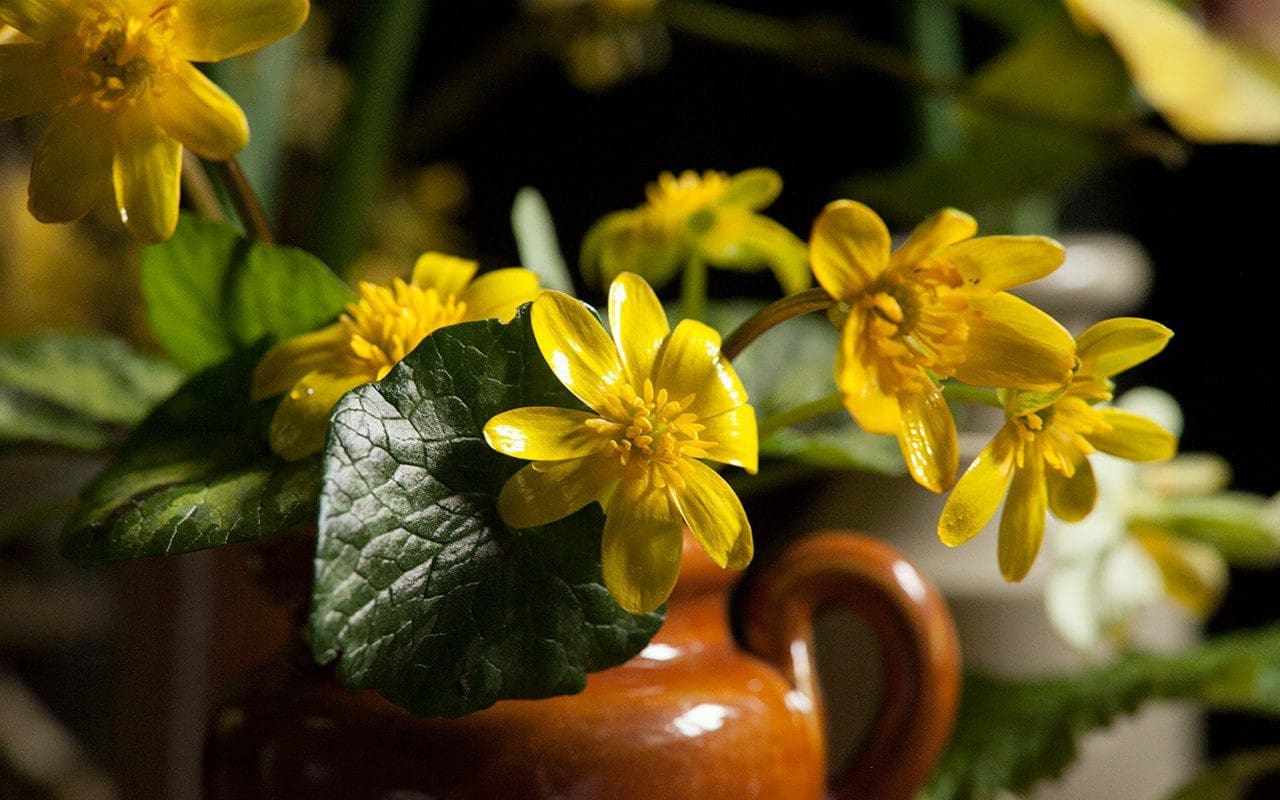 Lesser Celandine – Ranunculus ficaria
Lesser Celandine – Ranunculus ficaria
In all my years of designing it is always yellow that clients most often have difficulty with. ‘I really don’t like it’. ‘I don’t want to see it in the garden’. ‘Only in very small amounts’. Strong language which points to the fact that it prompts a reaction. Colour theory suggests the yellow wavelength is relatively long and essentially stimulating. The stimulus being emotional and one that is optimistic, making it the strongest colour psychologically. Yellow is said to be a colour of confidence, self-esteem and emotional strength. It is a colour that is both friendly and creative, but too much of it, or the wrong shade, can make you queasy, depressed or even turn you mad.
Whether I entirely believe in the thinking is a moot point, but I have found it to be true that yellow is a positive force when used judiciously. My first border as a teenager was yellow. I experimented with quantity and quality and by contrasting it with magenta and purple, it’s opposites. Today I weave it throughout the garden, using it for its ability to break with melancholy; a flash of Welsh poppy amongst ferns or a carefully selected greenish-yellow hellebore lighting a shaded corner.
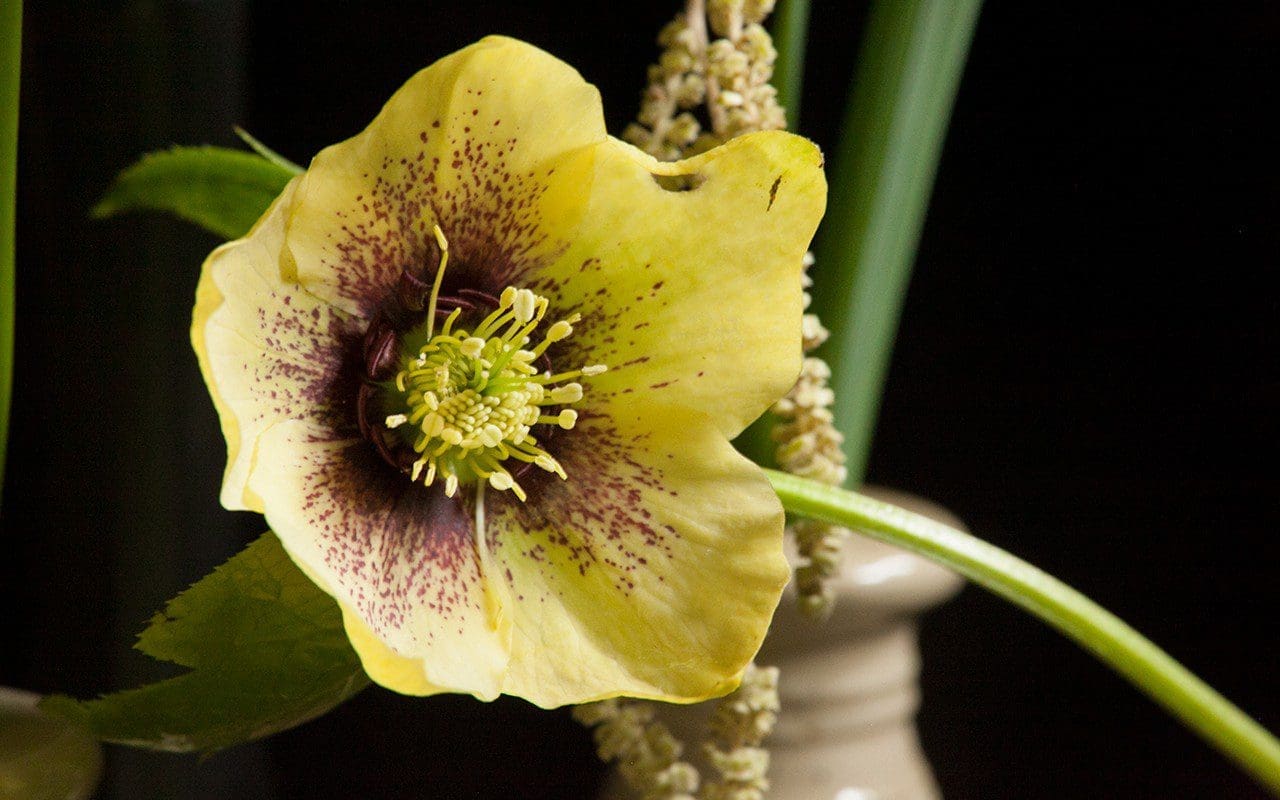 Helleborus x hybridus Ashwood Selection Primrose Shades Spotted
Helleborus x hybridus Ashwood Selection Primrose Shades Spotted
I remember talking to the textile designer, Susan Collier, about the use of yellow in her garden in Stockwell. She had repeated the tall, sulphur-yellow Thalictrum flavum ssp. glaucum throughout the planting and explained how she used it to draw the eye through the garden. ‘Yellow in textile design is extraordinarily persistent. It is noisy, but it lifts the heart. It causes the eye to wander, as the eye always returns to yellow.’
At this time of year, I am happy to see it, but prefer yellow in dashes and dots and smatterings. I will use Cornus mas, the Cornelian cherry, rather than forsythia, and have planted a little grove that will arch over the ditch in time and mingle with a stand of hazel. The fattening buds broke a fortnight ago, just as the hazel was losing its freshness. Ultimately, over time, my widely spaced shrubs will grow to the size of a hawthorn, the cadmium yellow flowers, more stamen than petal, creating a spangled cage of colour, rather than the airless weight of gold you get with forsythia.
We have started splitting the primroses along the ditch too. I hope they will colonise the ground beneath the Cornus mas. I have a hundred of the Tenby daffodil, our native Narcissus obvallaris, to scatter amongst them. The flowers are gold, but they are small and nicely proportioned. Used in small quantity and widely spaced to avoid an obvious flare, they will bring the yellow of the cornus to earth.
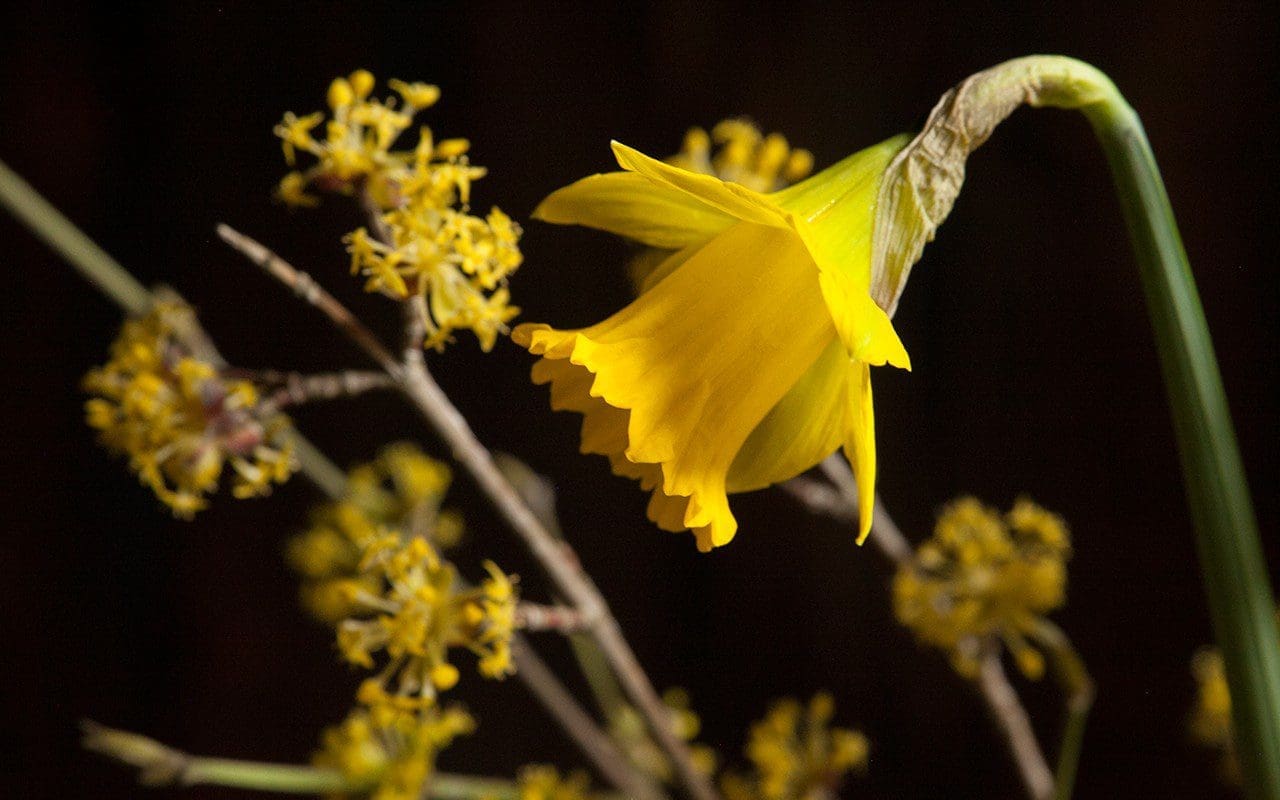 Narcissus obvallaris with Cornus mas (Cornelian cherry)
Narcissus obvallaris with Cornus mas (Cornelian cherry)
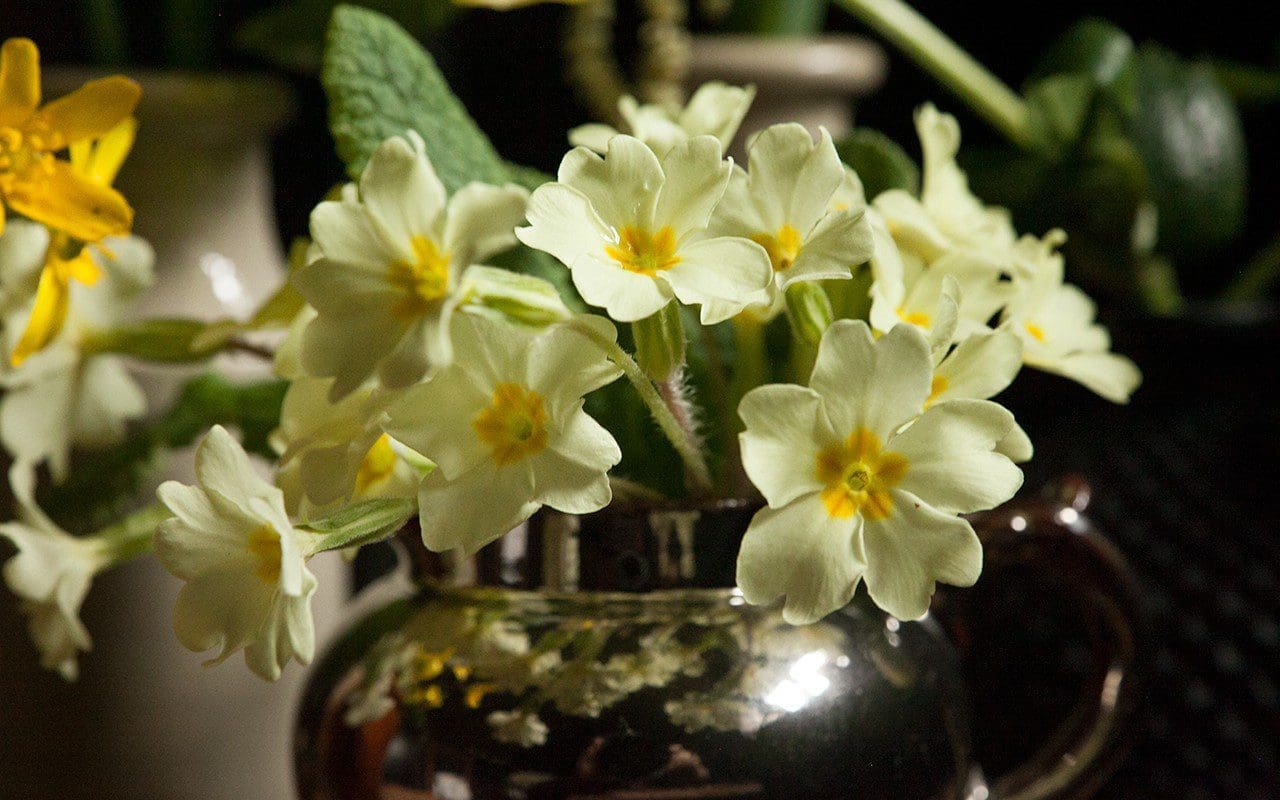 Primrose – Primula vulgaris
Primrose – Primula vulgaris
After several years of experimenting with narcissus, I have found that they are always best when used lightly and with the stronger yellows used as highlights amongst those that are paler. N. bulbocodium ‘Spoirot’, a delightful pale hoop-petticoat daffodil is first to flower here and a firm favourite. I have grown them in pans this year to verify the variety, but will plant them on the steep bank in front of the house where, next spring, they will tremble in the westerly winds.
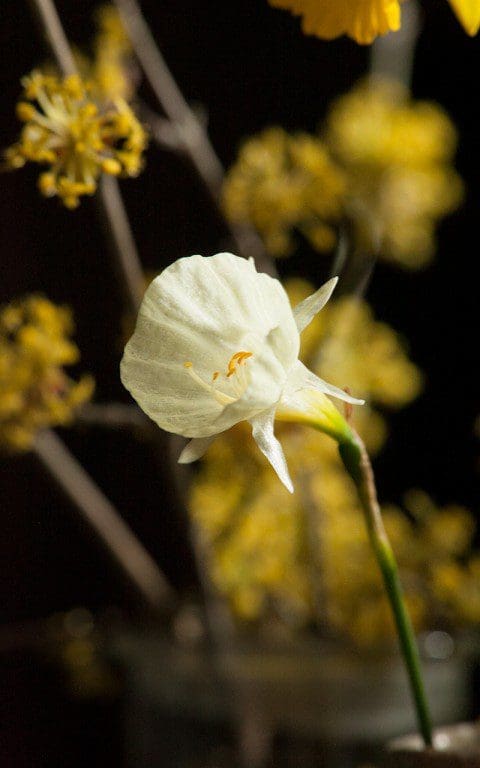 Narcissus bulbocodium ‘Spoirot’
Narcissus bulbocodium ‘Spoirot’
The very first of the Narcissus x odorus and Narcissus pallidiflorus are also out today, braving a week of overcast skies and cold rain. The N. pallidiflorus were a gift from Beth Chatto. She had been gifted them in turn by Cedric Morris, who had collected the bulbs on one of his expeditions to Europe. The flowers are a pale, primrose yellow, the trumpet slightly darker, and are distinguished by the fact that they face joyously upwards, unlike their downward-facing cousins.
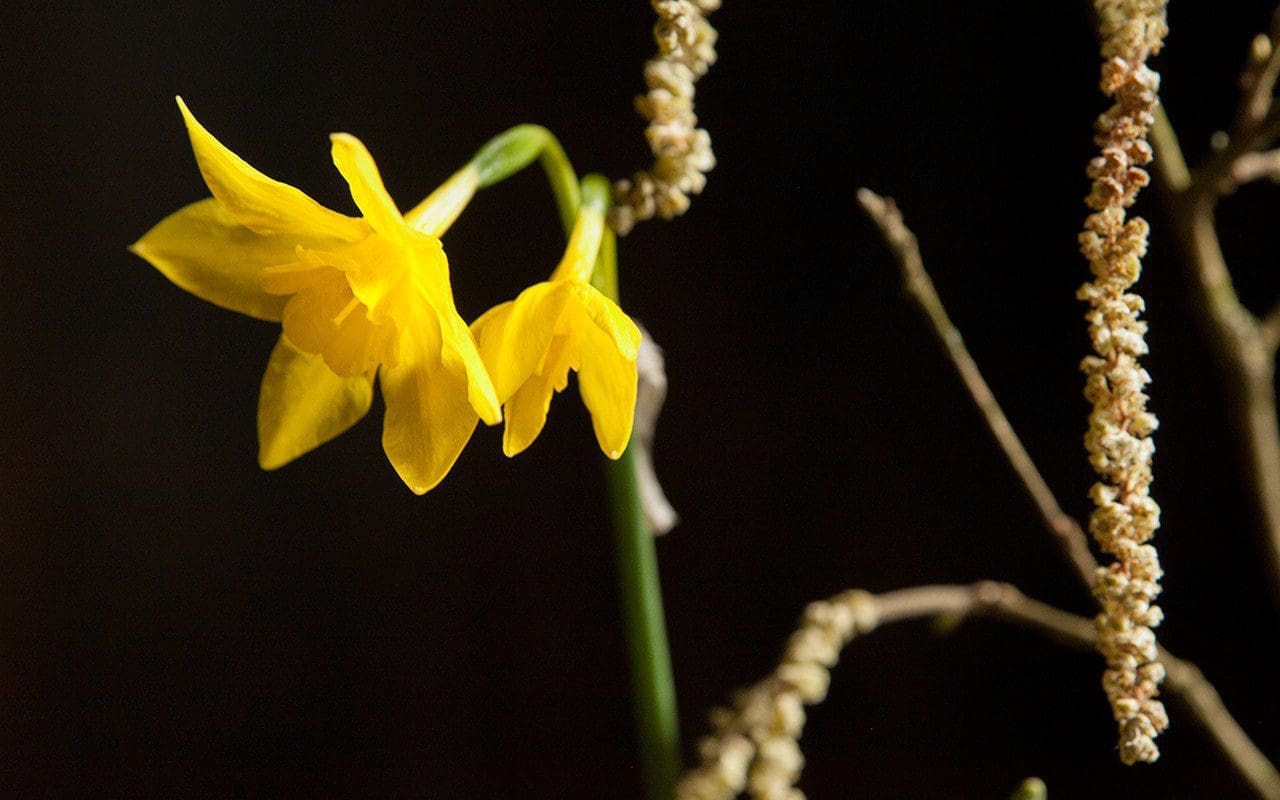 Narcissus x odorus
Narcissus x odorus
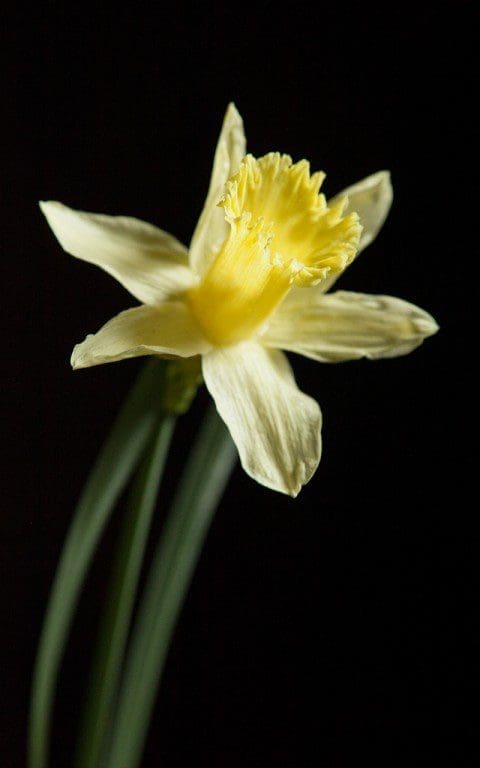 Narcissus pallidiflorus
Narcissus pallidiflorus
Our other native daffodil Narcissus pseudonarcissus has a trumpet the same gold as N. obvallaris, but with petals the pale lemon hue of N. pallidiflorus. It has an altogether lighter feeling than many of the named hybrids for this gradation of colour. We were thrilled to see a huge wild colony of them in the woods last weekend, spilling from high up on the banks, the mother colony scattering her offspring in little satellites. This is how they look best, in stops and starts and concentrations. I am slowly planting drifts along the stream edge and up through a new hazel coppice that will be useful in the future. A move that feels right for now, with all the energy and awakening of this new season.
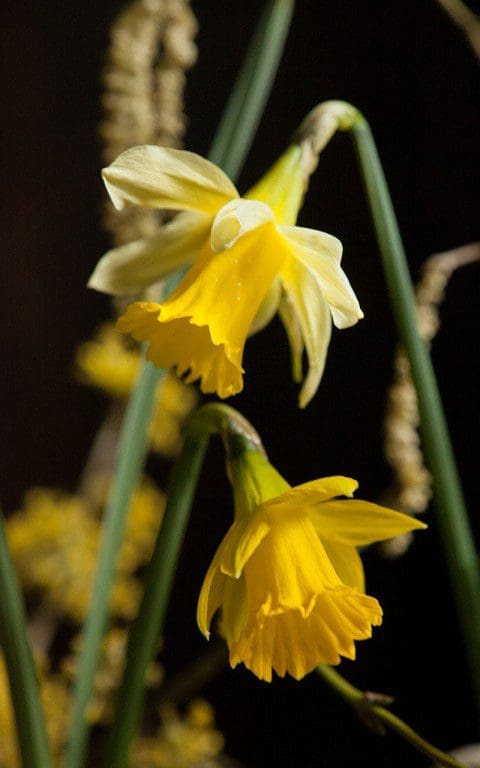 Narcissus pseudonarcissus (top), Narcissus obvallaris (bottom)
Narcissus pseudonarcissus (top), Narcissus obvallaris (bottom)
Words: Dan Pearson / Photographs: Huw Morgan
ALREADY A PAID SUBSCRIBER? SIGN IN
This year I have limited myself with the bulb orders as the newly landscaped ornamental garden is a year or so away from being ready for them. Bulbs are best placed where you know they can be left undisturbed so, in order for spring not to arrive without something new to look at, we have ordered a selection of tulips for cutting, a handful of Iris reticulata for pots and wild narcissus varieties to continue the ribbon that I am unravelling in stops and starts along the length of the stream at the bottom of the hill.
I started the ribbon when we first arrived, and have been adding to it every year with a couple of hundred bulbs. But that quantity of bulbs runs for just a small stretch, even if spaced in groups that smatter and appear at random among the leaf mould. So last year I grew impatient and ordered 500 and I’ve done so again this year to make the ribbon go the distance.
Our native Narcissus pseudonarcissus is most at home in open woodland where its young foliage can feast on early sunshine before the woodland canopy closes. I know them from Hampshire where they colonise hazel coppice on the lower slopes of the South Downs. Once they are established they clump densely, but the flowers rarely register as fiercely as the hosts of hybrid daffodils that you see littering parks in March. The wild daffodil is smaller in stature – just 30cm – and the flowers are fine, with twisting outer petals of pale primrose and only the trumpet a saturated gold.
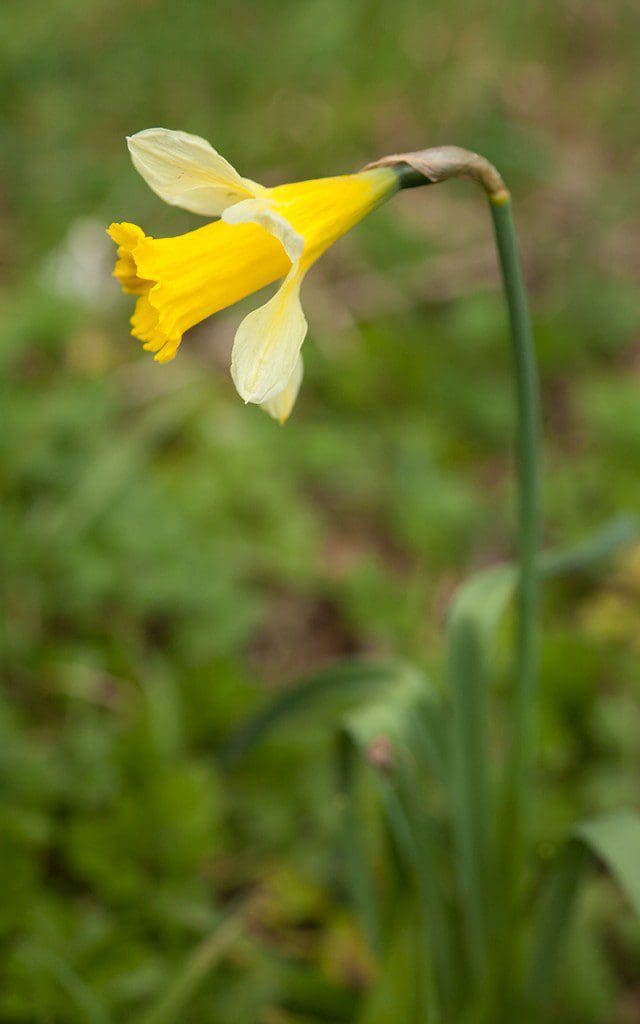 Narcissus pseudonarcissus
Narcissus pseudonarcissus
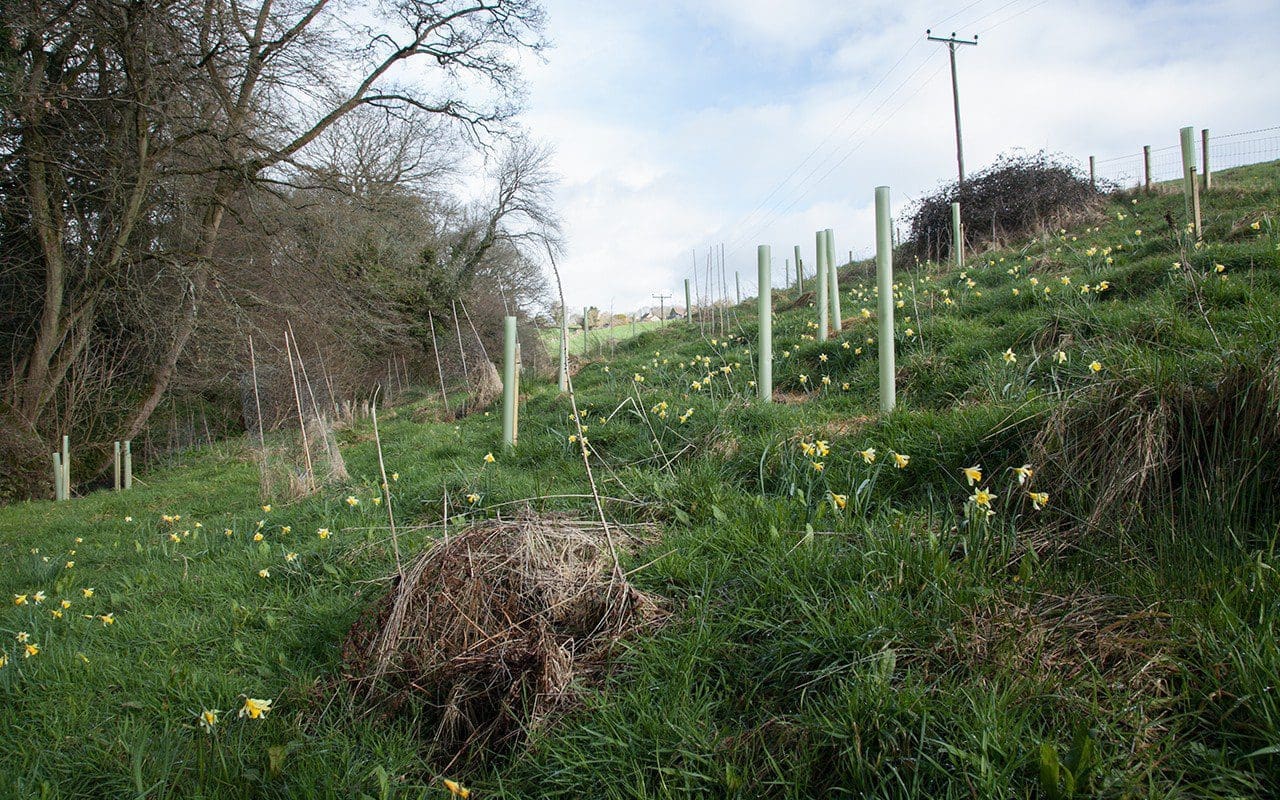 Narcissus pseudonarcissus massed under the new coppice on the lower slope of The Tump
Narcissus pseudonarcissus massed under the new coppice on the lower slope of The Tump
Unlike hybrid daffodils Narcissus pseudonarcissus is slower to establish and will often sulk for a couple of years before building up to a regular show of flower. No matter, it is worth the wait and I have already started my relay. The fourth leg runs into the area on the lower slopes of The Tump where the ground is too heavy for wild flowers and too steep for hay making and where I have taken some of the field back to plant a coppice. The hazel and hornbeam are just saplings, but it is good to think of the narcissus getting their feet in ahead of the trees.
About three years ago my parents bought me a sweet chestnut for Christmas, which I planted alone in the coppice. It will be allowed to become a standalone tree to pool shade in the future and rise up above the rhythm of the coppice as it ages. Here I have started a drift of Narcissus pseudonarcissus ssp. moschatus, the white-flowered form of the native, which has been in cultivation since the 17th century.
The elegant, downward-facing flowers are ivory as they open, fading slowly to a chalky white in all their parts. It is a beautiful thing and will be distinctive in the dim shade of the chestnut. I planted these bulbs as a memorial to my father who died the year the tree was planted and at the same time as the narcissus flower in late March. This variety is hard to find and this year I have only been able to source 50, but I am happy to add a small number annually. I like that it will take some time to come together and for the annual opportunity that this gives one to ruminate.
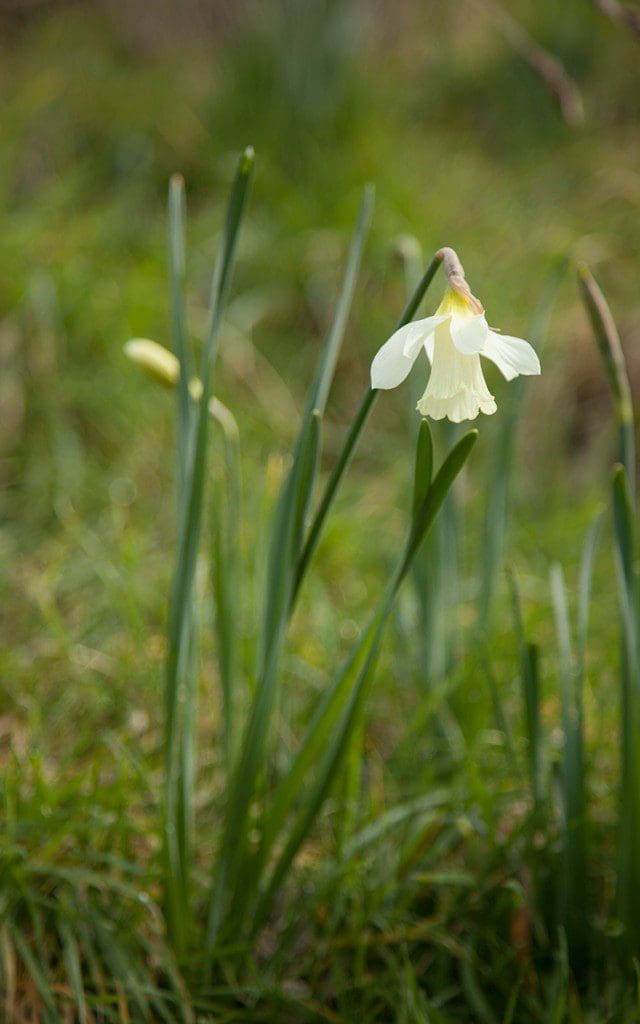 Narcissus pseudonarcissus ssp. moschatus
Narcissus pseudonarcissus ssp. moschatus
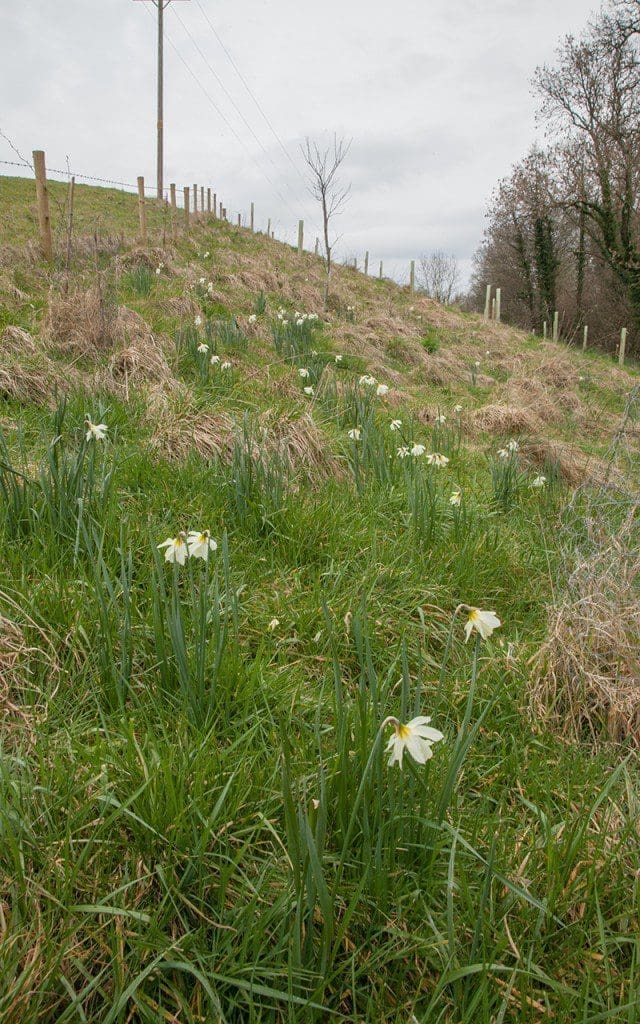 Narcissus pseudonarcissus ssp. moschatus planted around the sweet chestnut
Narcissus pseudonarcissus ssp. moschatus planted around the sweet chestnut
The Tenby Daffodil, Narcissus pseudonarcissus ssp. obvallaris, is the final part of this autumn’s order. This brighter yellow flower is also a native and, as its common name suggests, is most commonly found in Wales and the west. I have bought just a hundred and plan to trial it in the sun on the banks at the top of the brook near the beehive. Knowing your daffodils before you put them into grass is really important, as once they are in they are a nightmare to try and remove if they are wrong. I want to be confident that they aren’t too bright for their position and flare garishly where they shouldn’t. This will be my first time growing them for myself, so I want to get it right.
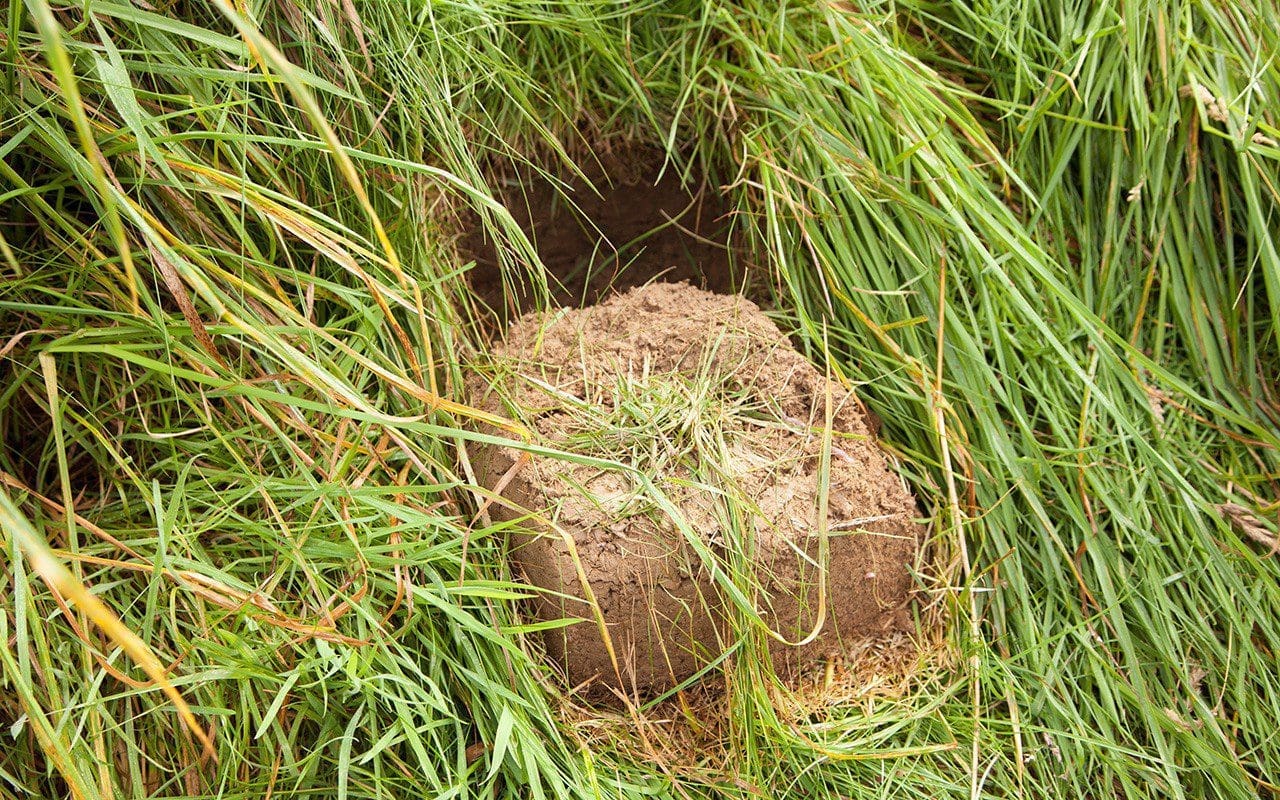 A square of lifted sod
A square of lifted sod
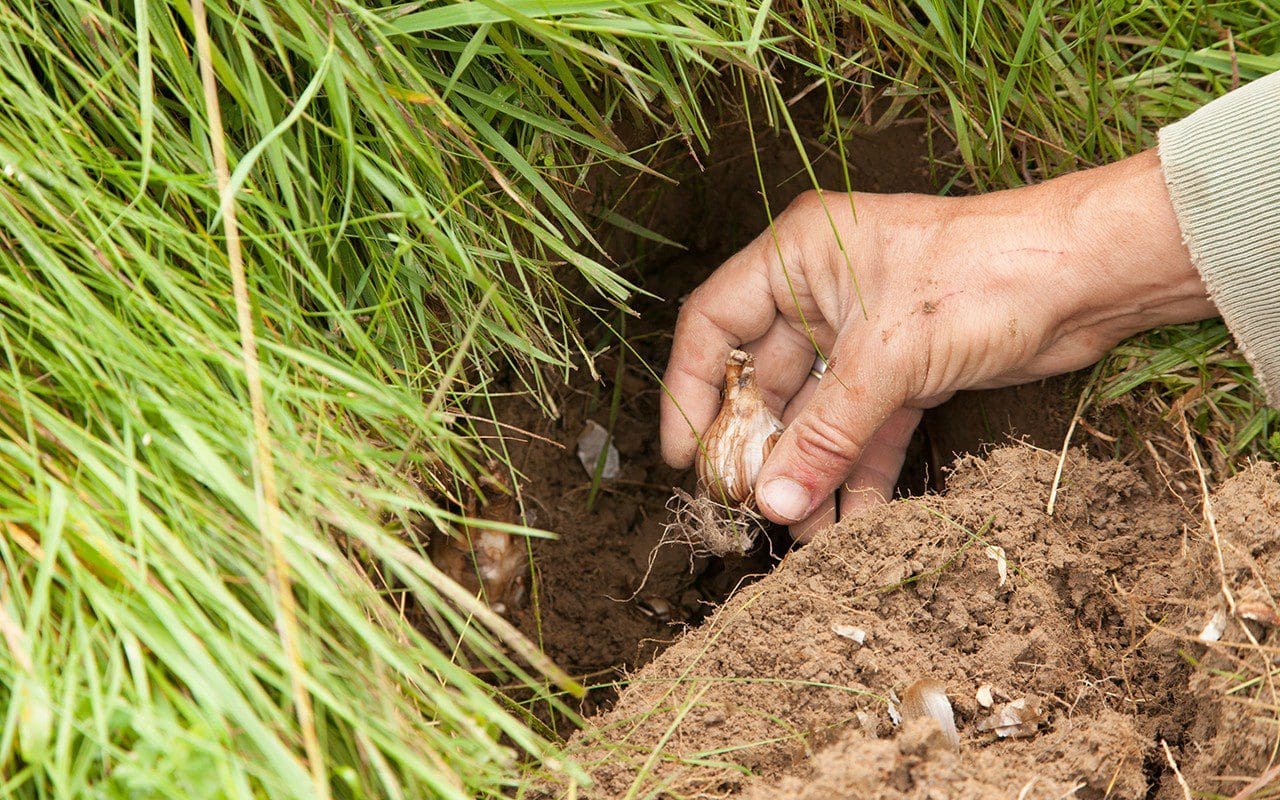 Plant the bulbs two and a half to three times the depth of the bulb
Plant the bulbs two and a half to three times the depth of the bulb
I am planting a little late this year as the wild daffodils prefer to be in the ground in August or September. They will be fine in the long run, but the green leaf tips are showing already and I can see that it would be better for them to be drawing upon new root rather than the sap of the bulb to produce this growth. To plant I lift a square sod of turf by making three slits and then levering the sod on the hinge that remains uncut. I put the bulbs in three to five per hole and at two and a half to three times the depth of the bulb. The flap is kicked back into place and firmed gently with the foot to remove any air pockets. A moment or two stepping back and imagining the same scene on the other side of winter is a very satisfying way to finish the day.
Words: Dan Pearson | Photographs: Huw Morgan
Published 8 October 2016
A new month today and there is a chill in the air and the grass is heavy with dew. The trees are yet to show colour, but the autumn bulbs are up and pushing a flare of brilliance against the drawing back that is happening around them.
Today’s posy, the first of October, captures some of this late vibrancy. I have known and grown Nerine bowdenii since I was a teenager. Geraldine, our neighbour, had them growing in the root zone of a huge fig at the foot of a south-facing wall. The fig had long outgrown any ambitions to be trained, but its lofty frame allowed you to walk underneath it and the sun to slide in and bake the ground at its feet. A good baking is what Nerine like as it makes them feel like they are not so far from their origins in the Drakensburg Mountains of South Africa. They grow there in rocky ground and, though they are capable of surviving a -15°c chill, a free-draining soil and reflected heat will help them to flower better here in Britain.
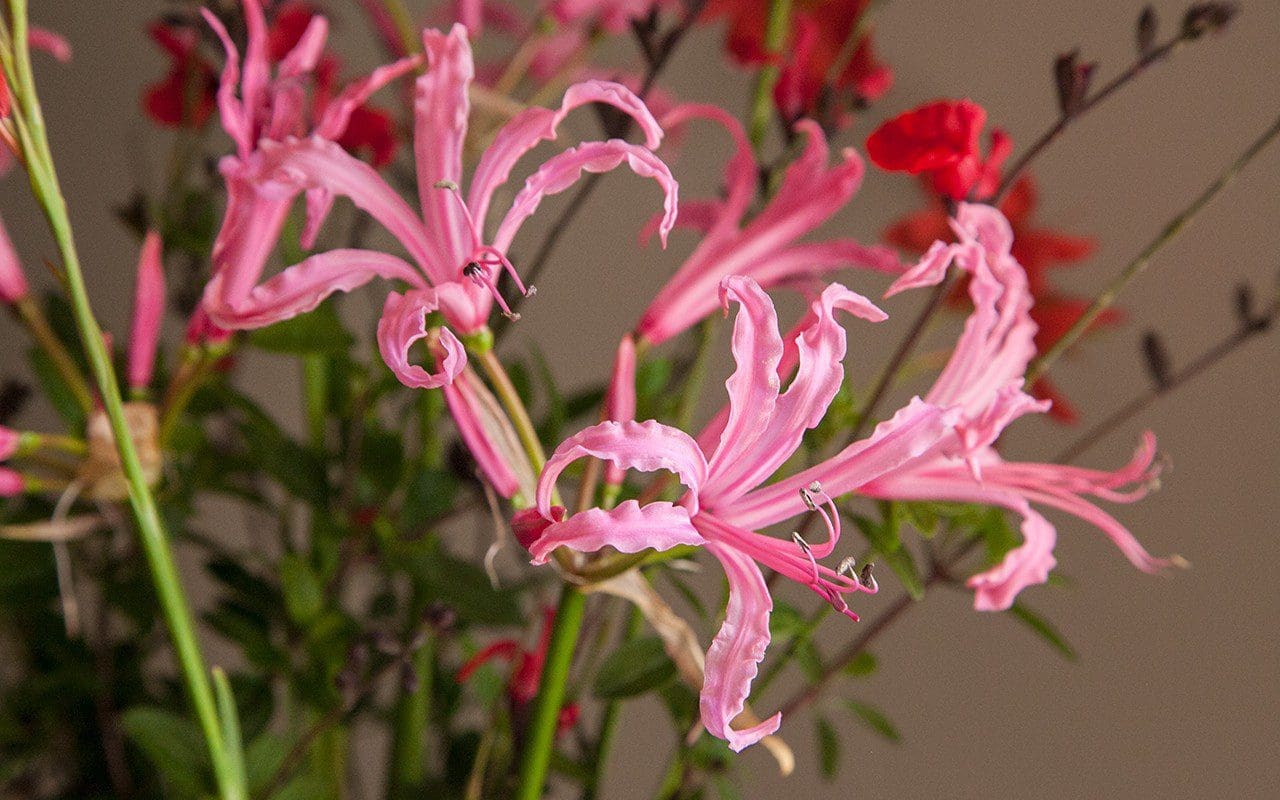 Nerine bowdenii
Nerine bowdenii
I have a collection of plants gathered from here and there as I have come across good forms. The best – the pure white ‘Blanca Perla’ and palest shell pink ‘Ostara’ – are kept in pots and brought up to the side door to keep us company when they are in flower. A mixed batch, which I bought unnamed and which range from white through to a hot sugary bubble-gum pink, are planted at the base of my espaliered pears in the Kitchen Garden. They get the benefit of a south-facing position, the radiated heat from the wall and, importantly, an absence of competition. Their foliage, which needs all the light it can get, hates to be overshadowed by neighbours so keep them to the front of a sunny bed if you want to grow them in company.
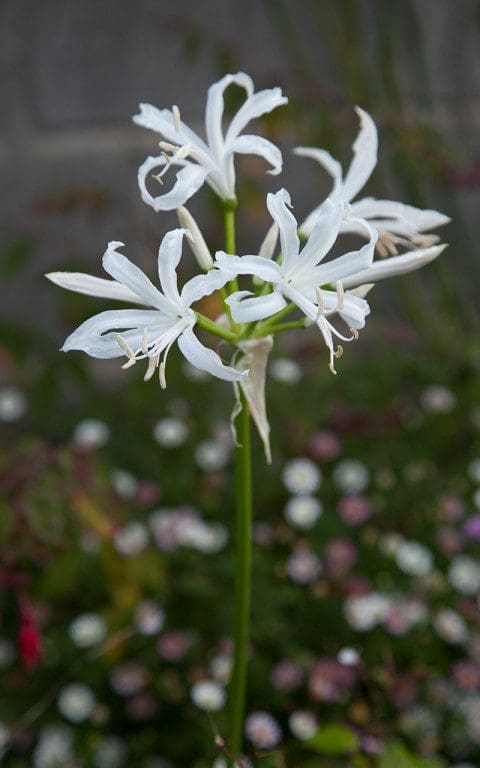 Nerine bowdenii ‘Blanca Perla’
Nerine bowdenii ‘Blanca Perla’
A row of Geraldine’s bulbs, which I have moved about with me from garden to garden over the years, are shortly to be transplanted to their new position from the stock beds. The best time to move them is immediately after they have finished flowering as their foliage is becoming dormant then. I will move entire clumps and not divide them, as they flower best when in a tight community. Established clumps will tell you how they like to live, for the bulbs will mound up out of the ground to sunbathe rather than dwell below the surface as most bulbs do. I will plant the clumps on a hot, south-facing slope where the sun slides in under a limbed-up holly. Though there is the necessary light for baking the conditions are tougher there and the bulbs will put more energy into flower than leaf.
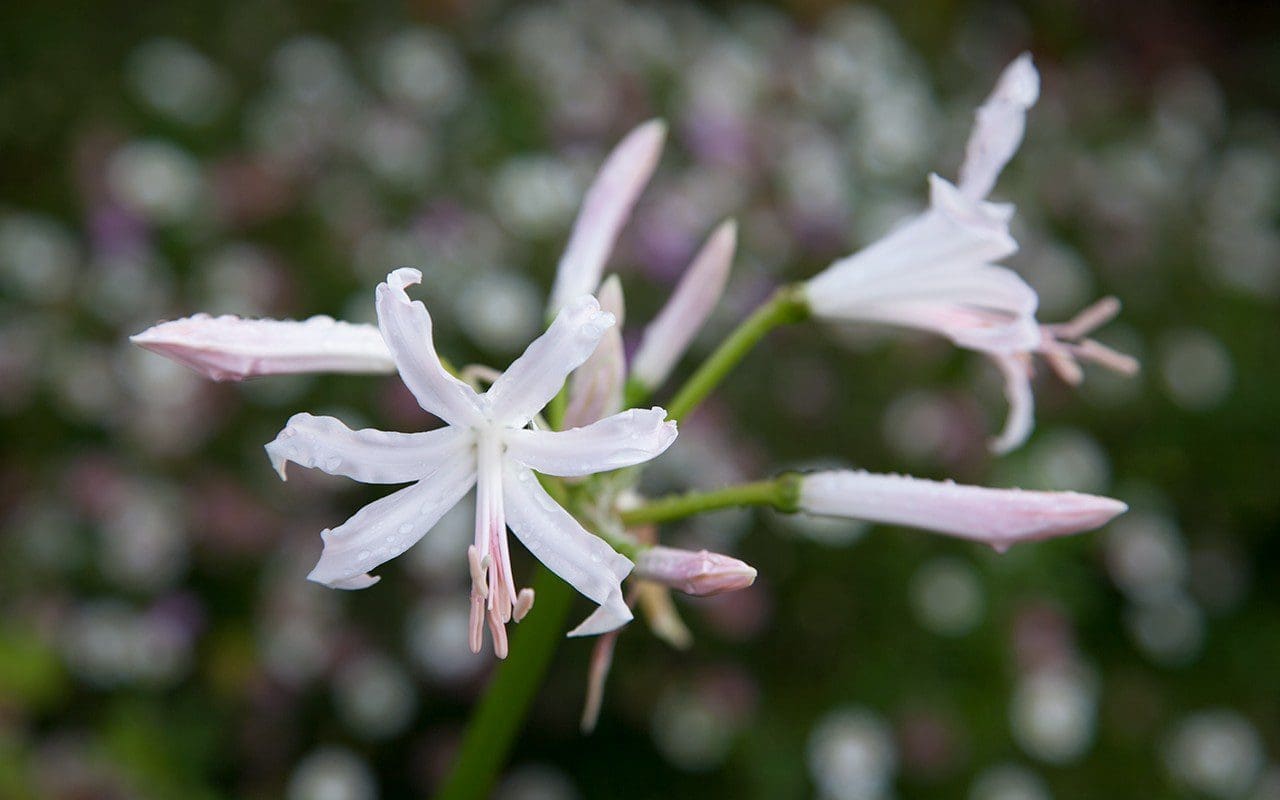 Nerine bowdenii ‘Ostara’
Nerine bowdenii ‘Ostara’
The flowers rise up as the summer foliage is waning and sap the last of its strength in the process. Tall stems – sometimes as much as a couple of feet – stand alone by the time the flower sheaths split in response to the flowers’ swelling. They are in flower for weeks, from early in September in some years, running on well into November if the weather is kind. As cut flowers they can last a good fortnight in a vase.
Schizostylis also hail from South Africa. In contrast to Nerine their foliage is almost evergreen, but they also hate competition and will fail to flower if overshadowed. However, here the parallel ends. They prefer damp ground or certainly moisture-retentive soil, so the posy makes a combination that is good for colour contrast, but not really achievable in the garden. That said, I have them here on the south-facing slopes and the plants have not complained in our hearty loam. They were given to me as spring divisions by Josie and Rachel, our neighbours up the lane. They run through their garden in drifts, appearing with asters and colchicum. So far, in the four years I have grown them in one place they have not needed dividing, but everything points to the plants needing it soon and they let you know when with shy flowering.
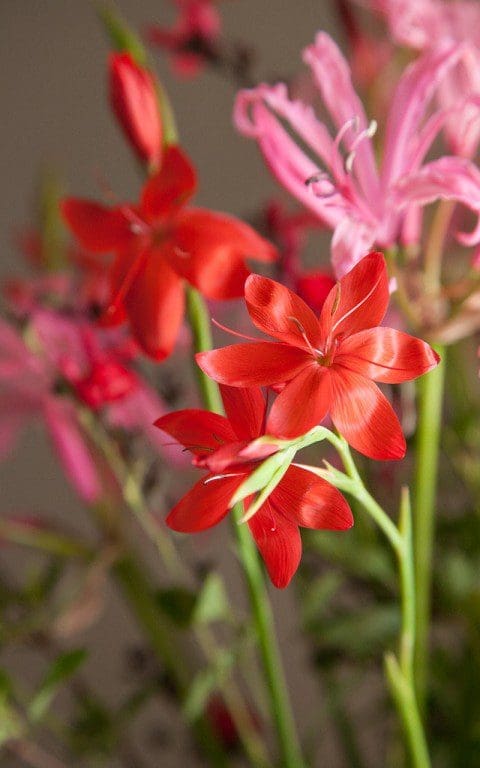 Schizostylis coccinea ‘Major’
Schizostylis coccinea ‘Major’
Schizostylis coccinea ‘Major’ is probably the best and most commonly available form. The satiny flowers are a gleaming brilliant red. In the past I have experimented with ‘Sunrise’, a soft apricot-pink, and have ‘Mrs. Hegarty’ – a pale shell pink – from the same neighbours, but both seem to be shy-flowering in comparison. I may simply have not found them a home that suits yet. My rule is that you have to move a plant at least three times to give it a chance of finding its niche, so I’m holding on final judgement for the moment.
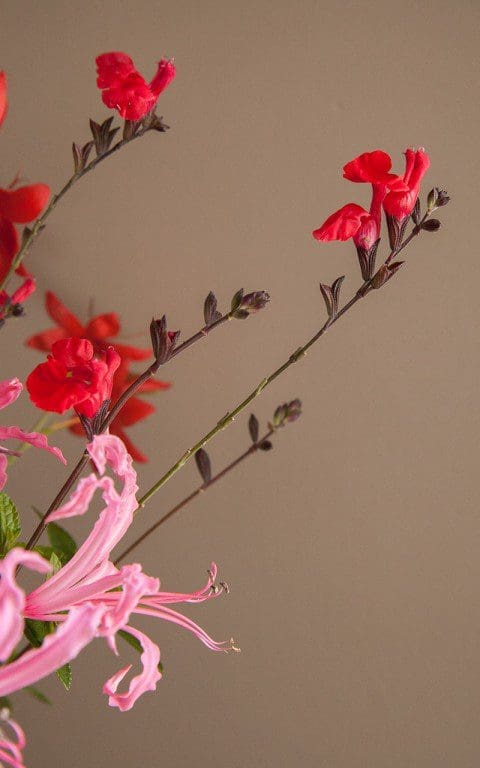 Salvia ‘Jezebel’
Salvia ‘Jezebel’
The Salvia ‘Jezebel’ is part of a salvia trial I’m running to find the good forms of Salvia greggii and it’s closely related cousins. The plants were selected from Dyson’s Nurseries three years ago now at the Dixter Plant Fair (running this weekend) and the best have proved themselves already. Bushy by nature and happy to live in your hottest, driest position, I have found they are excellent in pots or for prolonging the flowering period of a woody herb or mediterranean combination. ‘Jezebel’ has outgrown her neighbours, rising up to 90cm over the summer and flowering continuously since July. If you brush against them the sticky foliage and bronze calyces smell of blackcurrants and spice. The flowers age from a vivid cherry-red to a slightly softer pink before they fall. The bees love it and I know already that it’s a keeper.
Words: Dan Pearson / Photographs: Huw Morgan
ALREADY A PAID SUBSCRIBER? SIGN IN
ALREADY A PAID SUBSCRIBER? SIGN IN
ALREADY A PAID SUBSCRIBER? SIGN IN